Posts in Category: 2000–2004
published in 2000–2004
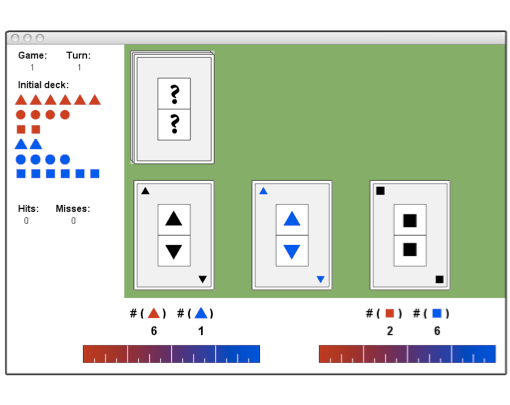
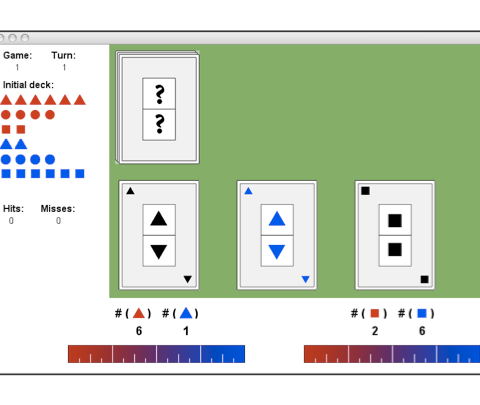
Paper: Dynamic memory updates in TRACS
| You can’t play 20 questions with nature and win. |
| Allen Newell (1973) |
Hansjörg Neth, Chris R. Sims, Vladislav D. Veksler, Wayne D. Gray
You can’t play straight TRACS and win: Memory updates in a dynamic task environment
Abstract: To investigate people’s ability to update memory in a dynamic task environment we use the experimental card game TRACS^tm (Burns, 2001). In many card games card counting is a component of optimal performance. However, for TRACS, Burns (2002a) reported that players exhibited a baseline bias: rather than basing their choices on the actual number of cards remaining in the deck, they chose cards based on the initial composition of the deck. Both a task analysis and computer simulation show that a perfectly executed memory update strategy has minimal value in the original game, suggesting that a baseline strategy is a rational adaptation to the demands of the original game. We then redesign the game to maximize the difference in performance between baseline and update strategies. An empirical study with the new game shows that players perform much better than could be achieved by a baseline strategy. Hence, we conclude that people will adopt a memory update strategy when the benefits outweigh the costs.
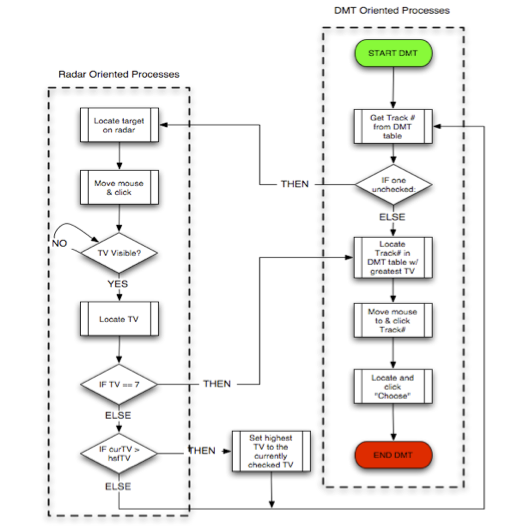
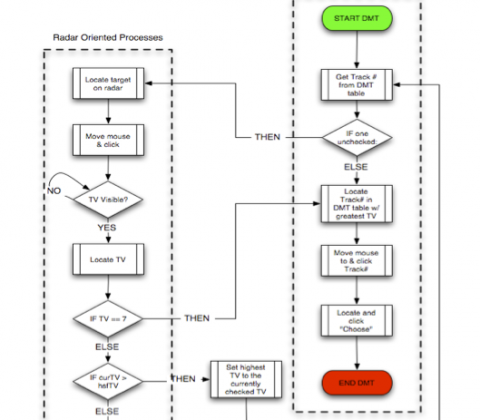
Paper: simBorgs modeling dynamic decision making
| For the exogenously extended organizational complex functioning as an integrated homeostatic system unconsciously, we propose the term “cyborg”. |
| M.E. Clynes and N.S. Kline (1960), Cyborgs and Space (Astronautics, 13) |
Christopher W. Myers, Hansjörg Neth, Michael J. Schoelles, Wayne D. Gray
The simBorg approach to modeling a dynamic decision-making task
Abstract: The simulated cyborg (or, simBorg) approach blends computational embodied-cognitive models of interactive behavior with artificial intelligence based components in a simulated task environment (Gray, Schoelles, & Veksler, 2004). simBorgs combine human and machine components. This combination of high fidelity cognitive modeling (human) and AI (machine) facilitates the development of families of models that allow the modeler to hold components (memory, vision, etc) at different levels of expertise without concern for cognitive plausibility. For example, rather than modeling human problem solving, the modeler can rely on various black-box techniques (i.e., cognitively implausible AI), thereby focusing on predicting how subtle differences in costs and benefits in interactive methods affect performance and errors. The current modeling endeavor adopts the simBorg approach in order to build a family of interactive decision-making agents.
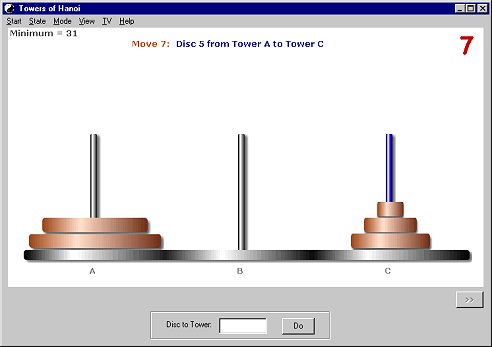
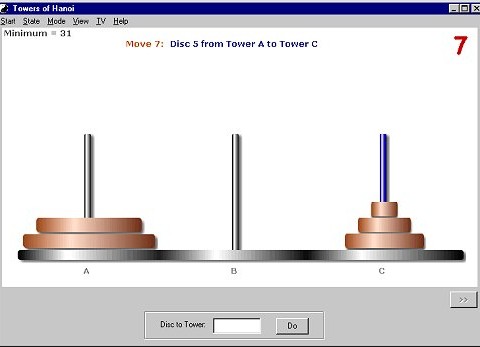
Paper: Thinking by doing?
| There is a co-ordination of senses and thought, and also a reciprocal influence between brain activity and material creative activity. In this reaction the hands are peculiarly important. It is a moot point whether the human hand created the human brain, or the brain created the hand. Certainly the connection is intimate and reciprocal. |
| A.N. Whitehead, Technical Education and its Relation to Science and Literature, p. 78. |
Hansjörg Neth, Stephen J. Payne
Thinking by doing? Epistemic actions in the tower of Hanoi
Abstract: This article explores the concept of epistemic actions in the Tower of Hanoi (ToH) problem. Epistemic actions (Kirsh & Maglio, 1994) are actions that do not traverse the problem space toward the goal but facilitate subsequent problem solving by changing the actor’s cognitive state. We report an experiment in which people repeatedly solve ToH tasks. An instructional manipulation asked participants to minimize moves either trial by trial or only on the last three of six trials. This manipulation did not have the predicted effect on the trial-by-trial move counts. A second, device manipulation provided some participants with an “exploratory mode” in which move sequences could be tried then undone without affecting the criterion move count. Participants effectively used this mode to reduce moves on each trial, but there was no clear evidence that they used it to learn about the problem across trials. We conclude that there is strong evidence for one sub-type of epistemic action (acting-to-plan) but no evidence for a second sub-type (acting-to-learn).
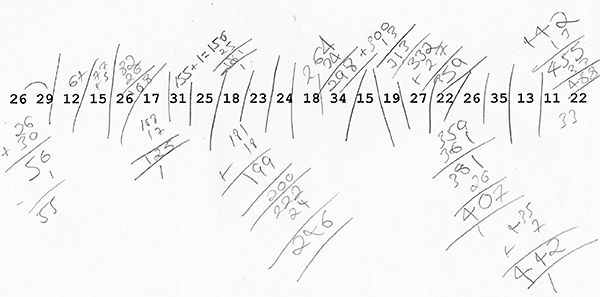
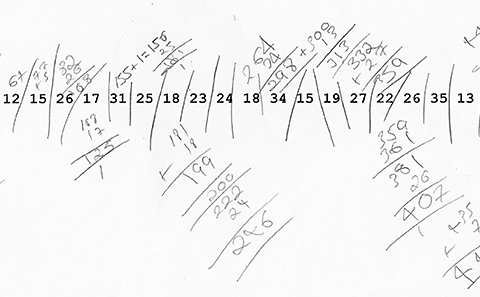
Paper: Addition as interactive problem solving
| These dual skills of manipulating the environment and processing the environment (…) allow us to reduce very complex problems to a series of very simple ones. (…) This is real symbol processing and, we are beginning to think, the primary symbol processing that we are able to do. Indeed, on this view, the external environment becomes a key extension to our mind. |
| McClelland, Rumelhart and the PDP Research Group (1986): Vol. 2, p. 46 |
Hansjörg Neth, Stephen J. Payne
Addition as interactive problem solving
Abstract: Successful problem solving depends on a dynamic interplay of resources between agent, task, and task environment. To illuminate these interactions we studied how participants added a series of single-digit numbers presented on a computer screen. We distinguished between four different user interfaces, each implementing a different mode of interaction with the displayed addends: look only, point, mark, and move. By collecting and analysing complete interaction protocols we were able to integrate overall performance measures with fine-grained behavioural process data on the strategies engendered by the different user interfaces. We discovered reliable differences in the chosen sequences of addends, which can be understood in terms of the cost-benefit structures provided by the interactive resources of the user interfaces.
Keywords: Embodied cognition, mental arithmetic, epistemic actions, complementary strategies, immediate interactive behavior (IIB).
Reference: Neth, H., & Payne, S. J. (2001). Addition as interactive problem solving. In J. D. Moore & K. Stenning (Eds.), Proceedings of the 23rd Annual Meeting of the Cognitive Science Society (pp. 698–703). Mahwah, NJ: Lawrence Erlbaum.
Related: Thinking by doing? | Immediate interactive behavior (IIB) | Arabic vs. Roman arithmetic | Taxonomy of actions | The cognitive basis of arithmetic | Interactive coin addition | The functional task environment
Resources: Download PDF | Google Scholar